You probably thought you’d never forget how to ride a bike.
Yet, I’ve recently found out that this is not entirely accurate. You may not
forget how to ride on two wheels, but riding efficiently and using the right
leg muscles, while the rest of the body remains still, is something different.
Our body changes constantly, and our way of riding adapts to this change. This
is what I learned last week, when after a year and 8 months since purchasing my
first road bicycle, I finally realized that I needed another fitting.
This is what my bike looked like when I bought it.
A number of reasons convinced me to do it. First, it was the
saddle: it started hurting after a couple of hours. Then, it was shoulder
tension: it would increase to the point that the entire upper body would be in
pain. Finally, it was my endurance on the road, which seemed to decrease, the
more miles I invested in riding. Of course, I didn’t expect that changing the position of
my hands relatively to the seat and the seat relatively to the pedals—the three
points of contact we normally have with the bike—would resolve all of my
problems. I knew I would have to do a lot of work on my own.
I arranged to see Kevin
Bailey, the bicycle-fitting guru at BikeNüt. Kevin knows that bicycle fitting
consists of a lot more than matching diagrams and key body dimensions. When we
ride, we move, and the fitting must be dynamic rather than a static one.
Kevin attached my bike to a
trainer and watched me ride for a while. He adjusted the handlebar to modify
slightly my hold on it. He made sure that my shoulder joints were properly
aligned with my hands. That adjustment made it more comfortable for me to hold
the drops, a position I usually found comfortable for only a few minutes at a
time.
New handlebar position
Kevin then observed that my back was slightly rounded, forming an awkward angle between my pelvis and the saddle. He eased the saddle back on the post by almost an inch, giving me more room to expand my lungs and relieve the pressure on my lower back. He also made me perform a few stretches on the floor, to make sure that my posture on the bike matched what I would normally achieve, when my muscles were warm and relaxed.
Old saddle position.
New position.
By far the biggest chunk of
time, however, was spent on my leg motion, checking the angle formed by the
femur and the tibia at the knee was the ideal one to allow the leg to spin the
pedals without wasted effort. It sounds so simple, but during the fitting
session I discovered that my bones are of different sizes in my right and left
legs. I also had developed the habit of moving on the saddle quite a bit,
changing frequently the amount of power I was able to develop. Finding an ideal
position for my pelvis against the back of the seat eliminated that silly
habit.
Much more relaxed on the bike.
Finally, Kevin checked the
alignment of my hips, knees, ankles, and feet, even checking that my shoes
provided the correct amount of arch support. Pushing against the pedals with
misaligned joints not only disperses a lot of the power but also develops
long-term problems, such as knee pain.
A lot of this sounds like
going to the doctor for the yearly physical and, well, it is. Also, like with
the doctor, I felt relieved to be out the shop and back on the bike. Yet, I
immediately noticed how weird it felt; my body position had changed, and so had
my hands, seat, and feet. As I have discovered during the past week and a half,
this is a good kind of weird.
The bike as it is now. After 20 months, only the frame remains the same.
I am still adjusting to the
changes, and sometimes, after a ride, it feels as if I am developing a whole
new set of muscles. I had been using my quads for most of the time, and now,
after the fitting, I put more effort in my glutei maximi. I develop more power with less effort. By keeping
my back more straight, I allow my lungs to work more efficiently (less hard
breathing on the hills) and the seat doesn't hurt. Finally, I hold the drops
for longer periods of time for added leverage, even while climbing, something I
had never done before.
In theory, minimizing my
effort on the bike should allow me to go faster and be less tired doing it.
Well, let’s just say that I’m still testing this theory.



































